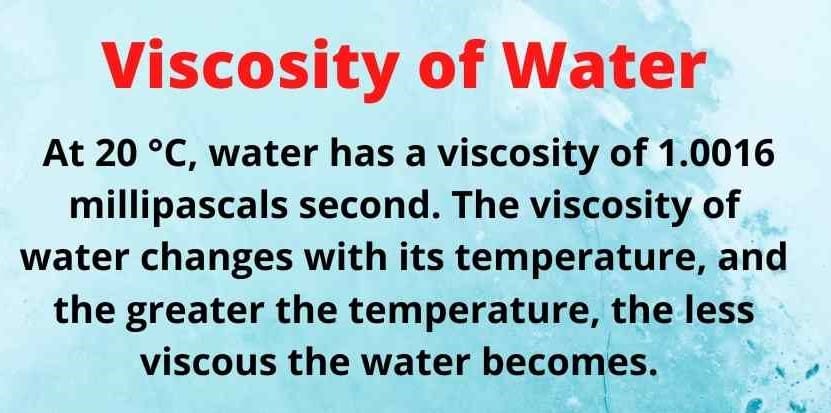The viscosity of a fluid (liquid or gas) is its resistance to a change in shape or movement of neighboring portions relative to one another. It describes the internal friction of a fluid in motion. For instance, Sticky oozy honey moves quite a bit slower than water because honey has a high viscosity than water. Viscosity is typically measured in pascal seconds (Pa-s), a unit of force equal to one kilogram per meter per second (kg/(ms)).

Table of Contents
Viscosity
Viscosity describes the internal friction of a moving fluid. A fluid with a high viscosity resists motion because its molecular structure causes a lot of internal friction. A fluid with low viscosity flows easily because its molecular structure causes very little friction when it is in motion.
Kinematic and dynamic viscosity are the two types of viscosity that are usually reported. The relationship between shear stress and shear rate in a fluid is known as dynamic viscosity. The relationship between viscous and inertial forces in a fluid is known as kinematic viscosity.
Viscosity Definition in Simple Terms
Viscosity is a measure of how resistant a fluid (liquid or gas) is to flow. In simpler terms, it is a measure of how “thick” or “sticky” a fluid is. The higher the viscosity of a fluid, the more difficult it is to pour or move the fluid, and the lower the viscosity, the easier it is to pour or move the fluid.
Viscosity is caused by the internal friction between the molecules of the fluid, and it depends on factors such as temperature, pressure, and the properties of the fluid molecules themselves. For example, honey has a higher viscosity than water because its molecules are more “sticky” and have a more complex shape, making it more difficult to pour.
Viscosity is an important property of fluids in many industrial and scientific processes, such as lubrication, flow measurement, and heat transfer.
Coefficient of viscosity
The viscosity coefficient is a measurement of the fluid’s resistance to flow. Gas viscosity is often lower than liquid viscosity. Dynamic viscosity is related to kinematic viscosity by the equation μ = ρv where ρ is the density of the fluid. The unit of dynamic viscosity μ is centipoise.
Viscous Liquids Examples
Some Examples of viscosity Or viscous substances are:
Kinematic Viscosity
The internal resistance to the flow of a fluid under gravitational forces is measured by kinematic viscosity. It is calculated by measuring the time in seconds necessary for a set volume of fluid to flow a known distance through a capillary within a calibrated viscometer at a carefully regulated temperature.
Viscosity of Water
At 20 °C, water has a viscosity of 1.0016 millipascals per second. That is for its dynamic viscosity. The viscosity of water changes with its temperature, and the greater the temperature, the less viscous the water becomes.
Newton’s Law of Viscosity
According to Newton’s viscosity law, “shear stress is directly proportional to velocity gradient.” The negative value of the velocity gradient between two adjacent fluid layers is directly proportional to the shear stress between the two adjacent fluid layers.
Solved Problems of the Concept of Visocity
Problem: A ball is dropped into a container filled with a liquid that has a viscosity of 0.01 Pa·s. The ball falls at a constant velocity of 0.2 m/s. What is the weight of the ball if its diameter is 2 cm and its density is 8000 kg/m^3?
Solution:
The force of gravity on an object is given by the formula F = mg, where F is the force, m is the mass of the object, and g is the acceleration due to gravity (9.8 m/s^2 on Earth). The weight of the object is simply its mass multiplied by the acceleration due to gravity.
To find the mass of the ball, we can use its density and volume. The volume of a sphere is given by the formula V = (4/3)πr^3, where r is the radius of the sphere. In this case, the diameter of the ball is 2 cm, so the radius is 1 cm (0.01 m). Thus, the volume of the ball is:
V = (4/3)π(0.01 m)^3 = 4.19 x 10^-6 m^3
The mass of the ball can be found by multiplying its volume by its density:
m = ρV = 8000 kg/m^3 x 4.19 x 10^-6 m^3 = 0.03352 kg
Now we can calculate the weight of the ball using the formula:
W = mg = 0.03352 kg x 9.8 m/s^2 = 0.328 kg·m/s^2 or 0.328 N
Finally, we can use the velocity of the ball and the viscosity of the liquid to find the drag force acting on the ball. The drag force is given by the formula F = 6πμrv, where μ is the viscosity of the liquid, r is the radius of the ball, and v is the velocity of the ball. In this case, the velocity of the ball is 0.2 m/s, and the radius of the ball is 0.01 m. Thus, the drag force acting on the ball is:
F = 6π(0.01 m)(0.01 m)(0.2 m/s) x 0.01 Pa·s = 0.0000377 N
Since the ball is falling at a constant velocity, the drag force must be equal and opposite to the weight of the ball, so we can set them equal to each other and solve for the velocity:
F = W 6πμrv = mg v = mg / 6πμr = 0.328 N / (6π x 0.01 Pa·s x 0.01 m x 0.01 m) = 8.76 m/s
Therefore, the drag force acting on the ball is 0.0000377 N, and the ball falls at a velocity of 8.76 m/s.
Summary Points
- Viscosity is a measure of a fluid’s resistance to flow. The higher the viscosity, the more resistant the fluid is to flow.
- Viscosity is caused by the internal friction between the molecules of the fluid. This friction arises due to the attraction between the molecules.
- The SI unit of viscosity is the Pascal-second (Pa·s), but other common units include the centipoise (cP) and the Poise (P).
- Viscosity is affected by temperature. Generally, as temperature increases, the viscosity of a fluid decreases, making it easier to flow.
- Viscosity is also affected by pressure. Some fluids, such as non-Newtonian fluids, may exhibit complex behaviour with changes in pressure.
- Viscosity is an important property of fluids in many industrial and scientific applications, such as lubrication, flow measurement, and heat transfer.
- Viscosity can be measured using a viscometer, which measures the time it takes for a fluid to flow through a narrow tube or another device.
- Different fluids can have very different viscosities. For example, honey has a much higher viscosity than water, while gases such as air have very low viscosity.
- Viscosity is important in the study of fluid mechanics, which is the branch of physics that deals with the behaviour of fluids in motion.
- Viscosity plays a role in many natural phenomena, such as the flow of lava, the movement of glaciers, and the behaviour of the Earth’s mantle.
Frequently Asked Questions
1. What is the kinematic viscosity of air?
The viscosity of air depends mostly on the temperature. At 15 °C, the viscosity of air is 1.81 × 10-5 kg/(m·s), 18.1 μPa·s or 1.81 × 10-5 Pa·s. The kinematic viscosity of air at 15 °C is 1.48 × 10-5 m2 /s or 14.8 CST.
2. What is viscous flow?
The viscous fluid is defined as a fluid with a high flow resistance. The degree of resistance between the fluid layers is measured by viscosity, which is a fluid factor. Fluids that have no or minimal internal friction resistance are categorized as non-viscous fluids.
3. Laminar flow definition
Laminar flow is a form of fluid (gas or liquid) flow in which the fluid flows smoothly and in predictable patterns. In contrast, turbulent flow is a type of fluid in which the fluid fluctuates and mixes irregularly.
4. What is the SI unit of viscosity?
The unit of viscosity is newton-second per square meter, which is usually expressed as pascal-second in SI units.
5. Why does oil float on water?
Oil floats on water because its density is lower than that of water. Density in liquids is defined as the amount of mass that may be filled in a cubic meter of volume. Water has a density of roughly 1000 kg/cubic meter, while oil has a density ranging from 800 to 960 kg/cubic meter.
6. What is air?
Air is a homogeneous mixture of different gasses. The air in the atmosphere is composed of nitrogen, oxygen (which is required for animal and human life), carbon dioxide, water vapor, and trace amounts of other elements (argon, neon, etc.). At higher elevations, air contains ozone, helium, and hydrogen.
7. Difference between Newtonian and nonnewtonian fluid?
A Newtonian fluid is one whose viscosity does not change with pressure (named after Sir Isaac Newton). However, if the viscosity changes as a result of stress or temperature changes, we call something a non-Newtonian fluid.
8. What is the melting point of water?
The melting point of pure water ice at 1 atmosphere of pressure is very close to 0 °C, which is 32 °F or 273.15 K.
9. What is the surface tension of water?
Surface tension refers to the ability of a liquid’s surface to resist an external force because of its molecules’ cohesion. At 20 °C (68 °F), the surface tension of water is 0.07275 joules per square meter.
10. Is water vapor a greenhouse gas?
Yes, water vapors are greenhouse gas. other examples are listed below:
More Interesting Topics
Heat Flux-An Overview
Osmosis Definition
How many cups in 128 ounces?
How Many Water Bottles is a Gallon
How Many Fluid Ounces Equal A Gallon
How Much is a Liter of Water?
- BCl3 Lewis Structure in four simple steps - November 1, 2023
- PH3 Lewis Structure in four simple steps - October 8, 2023
- PF3 Lewis structure in four simple steps - September 24, 2023



